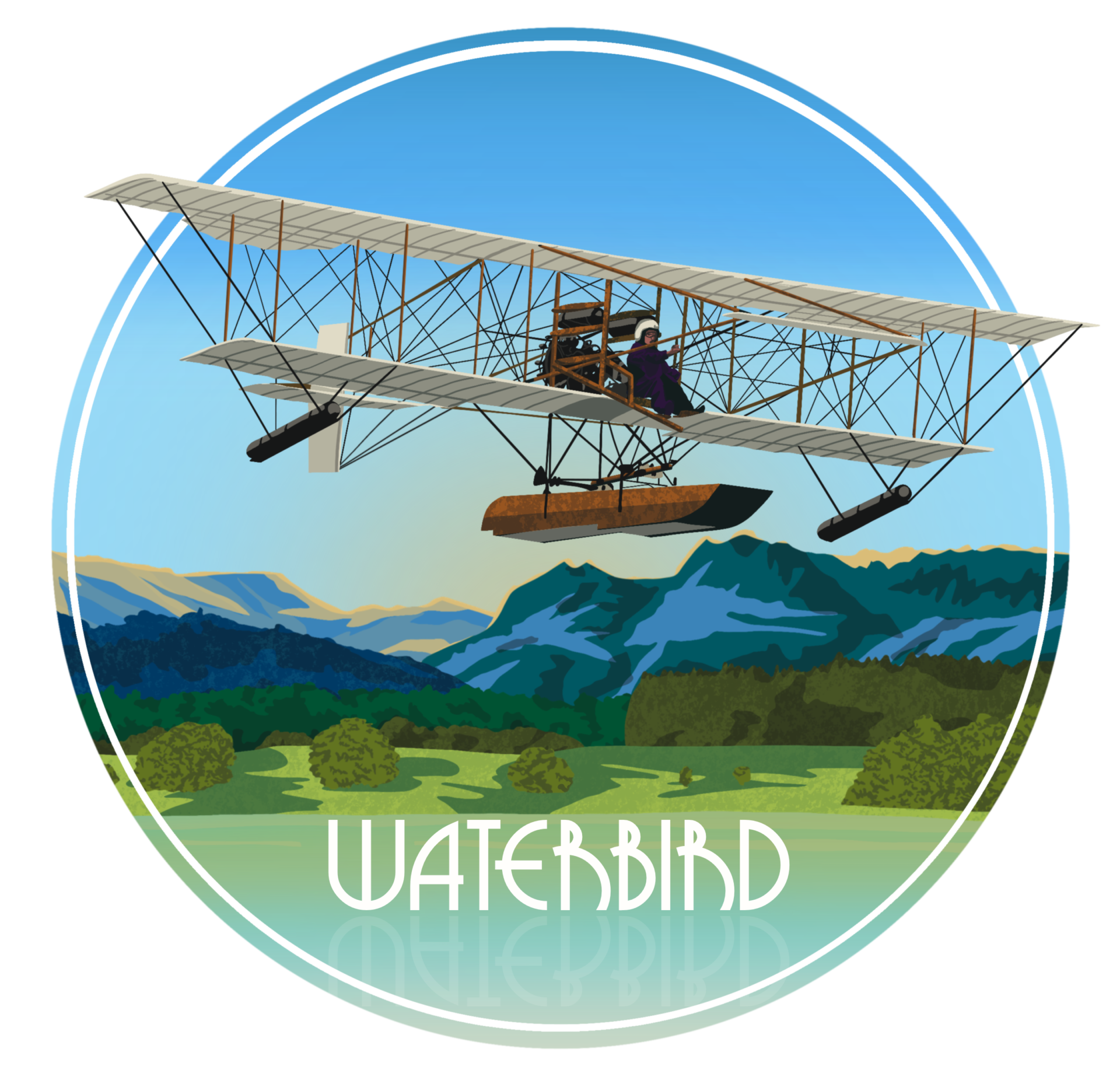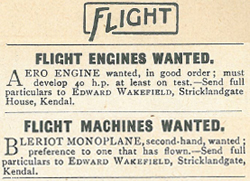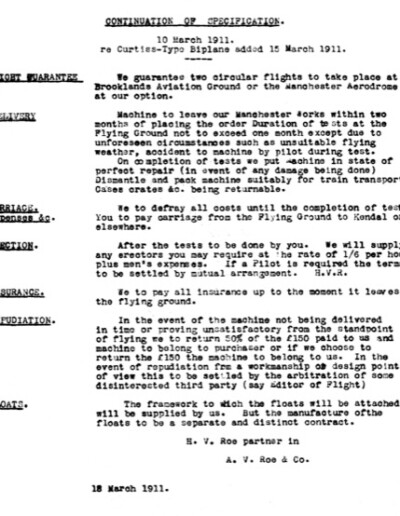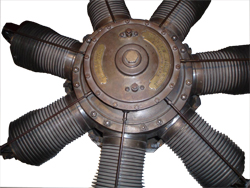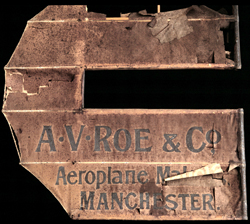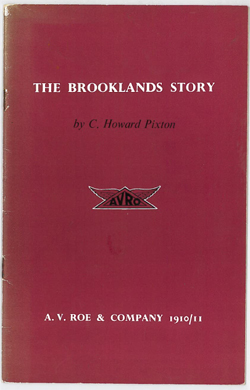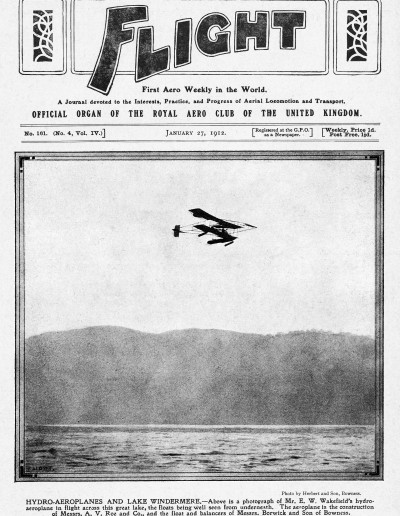A. V. ROE & COMPANY
Captain Edward Wakefield entered into an Agreement on 18 March 1911 with A. V. Roe & Co. (‘Avro’) for a Curtiss-Type Biplane and a Gnome 50 horse power engine at £625
Wakefield placed advertisements in Flight magazine of 24 September 1910 for an aero engine and a ‘flight machine’. Amongst the many replies, one came on 26 September from Humphrey Verdon Roe of Avro, Manchester. Avro had been formed on 1 January that year, the world’s first company to be registered as an aeroplane manufacturer. This advert is from the Aero Manual 1910.
Wakefield met with Humphrey at Brownsfield Mills, Manchester (they had the common background of service in the Boer War) and, following a letter from Humphrey to Wakefield on 6 October 1910, terms were reached for a Blériot-type monoplane at £100 without engine, propeller and wheels.
Wakefield had seen the Roe 1 Triplane, which he referred to in a letter to his wife as the ‘Bulls Eye‘, flown by Alliott Verdon Roe (later Sir Alliott Verdon-Roe Hon. FRAeS, FIAS) at the Blackpool Aviation Meeting on 19 October 1909 for a short distance before the transmission chain jammed.
Alliott’s younger brother Humphrey financed Avro. Humphrey owned H. W. Everard & Company which produced the line of Bull’s-Eye men’s trouser braces in a factory at Brownsfield Mills, Great Ancoats Street, Manchester. Hence the saying that Avro aeroplanes were kept up by Bull’s-Eye braces! So the aeroplane carried advertising on its side of not only ‘Bull’s-Eye’ but also ‘Avroplane’ which was the trading name.
Humphrey ‘had the customer’s point of view, and realised that the customer is always right. So the young Avro firm flourished under his businesslike management’. – Obituary in Aeronautics magazine, 5 August 1949.
After the flight of the world’s first practical hydro-aeroplane on 26 January 1911 by Glenn Curtiss at San Diego Bay, California, Wakefield ended his negotiations with Avro for a Blériot-type monoplane.
Wakefield acted quickly, writing to Humphrey on 2 February, meeting on 5 February at Brooklands, Weybridge which was the flying ground used by Avro, and meeting Alliott at Brownsfield Mills, Manchester on 26 February.
On 18 March, Avro entered into a private client commission for the first time: a biplane at £250 and a Gnome Omega 50hp No. 110 ‘pusher’ [the propeller was behind the wings] engine for £375. It is believed that there are only 2 such engines which have survived. Avro was an airframe designer/builder and supplied parts, but not an engine constructor; albeit there was a partnership with J. A. Prestwich & Company Ltd (‘JAP’) 1908-1909.
Initial flights of Avro aeroplanes were by:-
1908 Roe I Biplane
1909 Roe I Triplane
1910 Roe II Triplane
1910 Roe III Triplane
1910 Roe IV Triplane
1911 Avro Type D Biplane [there was no type A, B or C] – converted to a hydro-aeroplane at Barrow-in-Furness
1911 Biplane [there was no Avro designation] – converted to a hydro-aeroplane at Windermere and there known as ‘Waterbird’.
‘Alliott Verdon Roe’s early interest in hydro-aeroplanes was sparked by Wakefield’s order.’ – Eric Verdon-Roe, grandson.
Build of the aeroplane
Build took place at the basement workshop in Brownsfield Mills, superintended by the works manager Reginald Parrott. This photo is of Alliott and Parrott. – The Aero magazine, September 1912. He had seen drawings and photographs of the Curtiss-type.
The drawings at the top of this page, dated 9 March 1911 and signed by Parrott, are the oldest surviving for any Avro aeroplane.
Note use of the word ‘Ailerons’ on the drawing at lower left. – Curtiss argued that the aileron was a significant and distinct advance which ought not be legally covered by the Wright brothers’ patent claims, but on 14 January 1914 Curtiss lost an appeal against Orville Wright.
The rudder has the lettering A. V. Roe & Co. Aeroplane Makers, Manchester, and is the earliest surviving part bearing the legend ‘A. V. Roe & Co’. Photos of surviving parts are here.
Having been dismantled to exit Brownsfield Mills, transfer took place presumably by horse and cart, then via what is now Piccadilly railway station to Brooklands on 25 May for test-flying, where Wakefield met Humphrey on 29 June. Ronald Kemp, Louis Noël, Frederick Raynham and Francis Conway Jenkins (later Brigadier-General) all flew the aeroplane. Various changes were made by Alliott, as requested by Kemp and Raynham, including extending the span of the upper wings by 9 feet with additional ailerons and replacing the rudder which was considered to be too small. Howard Pixton, Chief Instructor of the Avro School, watched the first flight. He wrote in a booklet The Brooklands Story 1910/1911, that 1911 was an eventful year for Avro’s, including the aeroplane for Wakefield who took on one of the best Avro pupils – Herbert Stanley Adams, as pilot.
On 1 July, Wakefield wrote in a letter to his wife ‘At about 8 p.m. under young [he was 17] Mr. Raynham’s skilful piloting a splendid flight took Brooklands by storm. Rising slowly and turning at first in wide sweeps she soon gathered speed and height and sailed for some miles (4 at least) over houses and trees, and then landed in front of her hangar as gently as a thistledown. Thus she passed her contract test with flying colours’.
Avro Curtiss-type
Avro ended their triplane configuration with the Avro D biplane which first flew on 1 April at Brooklands with Pixton as pilot. Curtiss tested a triplane seaplane, but only for a short period. This was the first pusher for Avro since the initial Roe 1 Biplane. Curtiss-type elements included the tail, front elevator (‘canard’) and bamboo outriggers. Alterations at Brooklands also included replacing the Curtiss car-type control wheel with a column – ‘stick’ – which Alliott had invented, for which he obtained UK Patent No. 26,099 on 14 November 1907. Neither a Curtiss nor an Avro had flown with a Gnome engine.
The drawings are titled ‘AMENDED DESIGN for CURTISS BIPLANE’. Waterbird was described as an ‘Avro Curtiss-type’.
Waterbird was also a Farman-type. This plan of the Farman III is from Flight magazine, 16 October 1909. Note the front elevator, pole for the pilot to control the elevator, outriggers and engine behind the pilot, plus use of a Gnome 50hp engine. In 1909, Curtiss and Henry Farman both flew at the Reims Aviation Week, whilst Alliott and Farman met at the Blackpool Aviation Week.
When Adams was interviewed, he described Waterhen (the successor to Waterbird, which was built at Windermere) as a Farman-Curtiss type. – The Hull Daily Mail, 12 June 1913.
Waterbird at Windermere
Following delivery on 7 July to Hill of Oaks, Windermere, conversion to a hydro-aeroplane was accomplished. However, there was delay because the engine was found to be seriously defective and had to be taken to the Gnome works in Paris for repair. Wakefield appointed Gustav Blondeau, of aeroplane manufacturers Hewlett & Blondeau Ltd, to compile a report. (Hilda Hewlett was the first British woman to obtain an Aviator’s Certificate.) The defects included a crack or flaw through the engine’s side, 1 cylinder was not made by Gnome, 1 was a bad fit and another unfit for use, issues in 5 pistons and the exhaust valve rocker pin was broken.
On 25 November, flown by Adams, Waterbird made the first successful take-off and alighting on water outside of the USA and France where the very first hydro-aeroplane flight had taken place on 28 March 1910. It was the first successful flight in the world to use a stepped float, which Wakefield patented. 8 flights were carried out that day at distances of between 4 and 5 miles, and 2 days later exhibition flights were made.
By 25 January 1912, Waterbird had made about 60 flights over 38 days, the furthest of 20 miles and up to 800 feet.
Avro produced a postcard.
However, on 29 March 1912 Waterbird was written off when the hangar at Cockshott collapsed during a storm. For what happened to Waterbird’s surviving parts, please see here.
Dispute
The dispute over the engine and other issues escalated to Avro commencing High Court proceedings against Wakefield. Of the £54 claimed, he admitted £50, which he paid into court, and counterclaimed £267. William Grimble Groves acted as Arbitratror – there was reference in the Agreement to settlement by Arbitration. Groves lived at Holehird, Windermere and was a director of Groves & Whitnall Ltd, brewers of Salford, Manchester. On 20 June 1913, he awarded £37 to Avro, with each side to pay their own legal costs. – It is interesting to note that Avro’s barrister, Edward Acton, became the first judge to be appointed from the County Court to the High Court and was knighted; whilst Wakefield’s barrister, Ernest Wingate-Saul, went on to be a King’s Counsel and Recorder of Preston also being knighted.
Avro D at Barrow-in-Furness
Pixton had given a demonstration flight at Brooklands of the prototype Avro D to Commander (later Air Vice-Marshal Sir, KCB CBE) Oliver Schwann who paid £700 and taught himself basic pilot skills. In the second week of June, despatch took place to Barrow where floats were attached. On 18 November at Cavendish Dock, Barrow, piloted by Schwann, the Avro D left the water for 50-60 yards but crashed upon falling back into the water.
On 2 April 1912, flying the Avro D at Barrow, Sydney Sippe (later Major, DSO OBE FRAeS) made the first successful flight from seawater in Britain.
Oscar Gnosspelius at Windermere
Earlier on 25 November, Oscar Gnosspelius had flown from Windermere, but he also crashed on alighting. In February, he had made straight and level flights at Brooklands, having been taught by Pixton. Gnosspelius No. 2 flew successfully on 14 February 1912, when Gnosspelius was the pilot. In April 1912, Gnosspelius invited Kemp, whom he had met at Brooklands, to Windermere in order to more fully explore the flight envelope of his hydro-aeroplane. Kemp made a series of flights between the 12th and 17th, including one of 20 minutes.
Gertrude Bacon about Avro and Windermere
In July 1912, Gertrude Bacon flew as a passenger at Windermere in Waterhen and the Deperdussin, so achieving world firsts as a woman in a hydro-aeroplane and a hydro-monoplane.
In her book Memories of Land and Sky, she wrote: ‘I visited the aerodromes and aeroplane works that by then were springing up in all directions. One of the earliest of the latter I found in a mill outside Manchester, where half the building was devoted to the manufacture of men’s braces, and the other to ‘Avroplanes’. Of the former the most romantic example was undoubtedly Windermere.’ It is presumed that this article was written by her.
Seabird/the Avro at Windermere
Avro built an aeroplane for John Duigan, similar to the Avro D, which Wakefield bought from him for £180. Following transportation from Brooklands to Windermere, new wings, designed by Gnosspelius, were made and the ex-Waterbird engine installed. It was first flown at Windermere on 28 August 1912 becoming known as Seabird and later as the Avro.
Avro 501
In December 1912, Adams test-flew the Avro 501 amphibian at Eastchurch on behalf of Avro, the float having been designed by Gnosspelius, built to the orders of the Admiralty. Like the aeroplane which would become Waterbird, construction took place at Brownsfield Mills.
Avro 503
The Avro 503, a slightly larger version of the Avro 501, first took off from the River Adur at Brighton on 28 May 1913, piloted by Raynham. This was the first aeroplane to have floats designed by Avro. On the following day, he carried as a passenger John Alcock who was working at Brooklands as a mechanic and made the first Atlantic crossing in 1919, which brought an award of £10,000 from the Daily Mail.
The Daily Mail Prizes
The Daily Mail, founded by Lord Northcliffe in 1896, stimulated aviation by awarding prizes between 1907 and 1930. In 1907, Alliott won £75 in a model competition of over 200 entries whose motive powers included petrol, steam, clockwork, elastic and compressed air, which helped fund the full-size aeroplane. In August 1909, Lord Northcliffe wrote to Blackpool Town Hall suggesting that an air display be put on. Wakefield derived his inspiration to fly off water from the Blackpool Aviation Meeting in October 1909. On 14 February 1914, Raynham flew an Avro 504 to 15,000 feet. Bought by the Daily Mail, displays were carried out at towns around the British coast.
Between 1909 and August 1914, Lord Northcliffe gave what was then the enormous sum of £24,050 in prizes, and offered £5,000 for the first round Britain flight by a seaplane, but World War 1 ended all competition flying. The prototype Avro 510 seaplane was built for the cancelled 1914 Circuit of Britain race and purchased by the Admiralty, the cheque being handed by Captain (later Air Chief Marshal Sir) Arthur Longmore to Alliott on 20 January 1912. Longmore had test-flown Waterbird for the Admiralty, his first take-off from water.
Captain Howard Pixton
On 20 April 1914, flying a Sopwith seaplane at Monaco, Pixton became the first Briton to win the Schneider Trophy.
From 21 July until October 1919, Pixton operated two Avro 504 seaplanes (still displaying their military serial numbers) at Cockshott, Windermere for the Avro Transport Company, having taken a lease of the hangar from Wakefield. He carried out joyriding flights, instruction and delivery of newspapers to the Isle of Man.
Major Sydney Sippe
Sippe (who had flown the Avro D at Barrow) flew an Avro 504 (No. 873) on 21 November 1914 during a Royal Naval Air Service raid on the Zeppelin factory at Friedrichshafen, part of the first strategic bombing campaign, for which he was awarded the Distinguished Service Order and the Légion d’honneur.
On 12 July 1920, a dinner was given by the proprietors of Aeronautics magazine at the Connaught Rooms, London to the survivors of the First Hundred British Aviators and the Pioneers of British Aviation. It had been suggested by Major C C Turner, who was then editing Aeronautics. Amongst the Aviators invited were Alliott (No. 18), Pixton (No. 50), Longmore (No. 72), Conway Jenkins (No. 74), Kemp (No. 80), Raynham (No. 85) and Stanley-Adams (No. 97). Stanley-Adams was unable to attend. The Pioneers included Humphrey, Parrott, Noël [No. 119], Gnosspelius, Sippe [No. 172] and Gertrude Bacon. Many of the tables were arranged to bring together old associates. Thus there were Brooklands and Eastchurch tables, and so on.
Crossley Motors Limited
Crossley Motors Ltd acquired 68.5% of the shares in A. V. Roe & Co Ltd on 26 October 1920. Crossley took over Avro’s car manufacturing business, but Avro independently continued aeroplane manufacturing operations and retained its name. For example, No. 9 Burnley Corporation Bus, with bodywork by John Knape & Son Ltd which sold Crossley cars, was rebuilt by Avro in 1928.
Saunders-Roe Limited
In 1928, Sir Alliott sold his shares in A. V. Roe & Co Ltd to John Siddeley. Seeking a company to pursue his seaplane ideas, on 12 December 1928 he bought a controlling interest in S. E. Saunders Ltd from Sam Saunders. The company changed its name on 3 July 1929 to Saunders-Roe Ltd (this image is of the Princess) with a trading name of Saro and flying boat production.
The first design was the Saro A.17 Cutty Sark, of which 12 were built. G-ABBC, named Progress 1, was based at Blackpool Airport and operated from the foreshore to Douglas Bay, or Ronaldsway Airport, Isle of Man by British Amphibious Airlines Ltd during 1932-1933. It was the first scheduled internal air service within the British Isles.
On 22 February 1932, Windermere Urban District Council refused an application by British Amphibious Airlines to transport passengers at least once a week to the lake and to carry out joy rides.
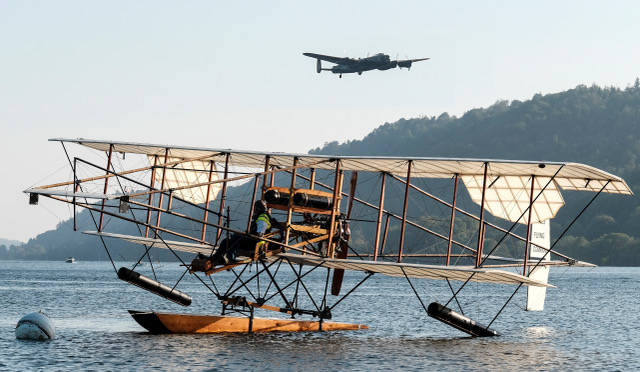
– Avro Curtiss-type replica and Avro Lancaster B.1 at Windermere in 2024
– Grateful thanks to Eric Verdon-Roe, grandson of Sir Alliott Verdon-Roe, for providing information.
